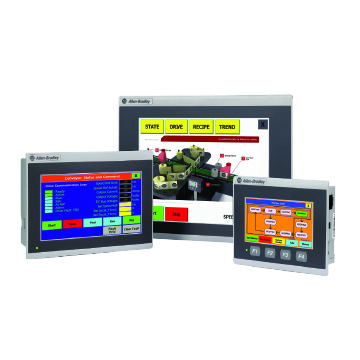What is the Best PanelView for Your Application?

PanelView 800, PanelView Plus 6 Compact, PanelView Plus 6, PanelView Plus 7 Standard, and soon the PanelView Plus 7 Performance and PanelView 5000! So many choices…which one do I choose?
When I heard of all of these new offerings, the first thing that came to mind was confusion. It is easy to get lost in all of the technical specifications for each family. It is my goal to help you understand which product family is the right fit for your application.
If you design machines that typically use MicroLogix or Micro800 controllers and you are in an ultra-competitive market, the PanelView 800 is an excellent choice. This terminal has a low acquisition cost and uses free programming software –Connected Components Workbench 8.0. This is Rockwell’s entry-level operator interface for small control systems. The PanelView 800 replaces the older PanelView Component platform.
If your control system utilizes CompactLogix and your operator interface applications can stay below 25 displays and 200 alarms, a great fit would be the Panelview Plus 6 Compact or Panelview Plus 7 Standard. While these terminals can communicate with Micro800 and MicroLogix controllers, they were designed to be cost effective solutions that provide upscale features to compliment higher performance Logix processors. These operator displays are DC-powered, communicate with one processor, and offer data collection capabilities. The Panelview Plus 7 Standard is the latest offering with more screen sizes and higher resolution displays than the Panelview Plus 6 Compact. To program a Panelview Plus 7 Standard, you will need FactoryTalk View ME Studio 8.0 or higher. These terminals are Rockwell’s mid-range operator interface offering for small to medium-sized control systems. These are a popular choice for OEMs using CompactLogix.
If your control system utilizes ControlLogix and your application involves a complex machine or system (i.e. utility house, HVAC system, Conveyor system, etc.), then the PanelView Plus 6 or PanelView Plus 7 Performance will be the best solution for local control. These terminals support connections to multiple controllers and can support 300 screens, 3000 tags, and 400 alarms. PanelView Plus 6 terminals have serial and Ethernet communications. They also have the ability to support legacy DH+ and DH485 communications. The PanelView Plus 7 Performance doesn’t support these legacy networks but offers an embedded switch with two Ethernet ports. This allows the PanelView Plus 7 to be part of a linear or Device Level Ring (DLR) network. The PVP6 and PVP7 terminals are programmed with FactoryTalk View ME Studio. These terminals are Rockwell’s premier operator interface offering for large machine and system-level control.
Lastly, if your control system involves CompactLogix or ControlLogix, the PanelView 5000 will be a new operator interface offering with the first release coming late summer. The PanelView 5000 will use a new software program called View Designer which is embedded in the Studio 5000 suite along with Logix Designer (formerly called RSLogix 5000). This design software will be completely different from FactoryTalk View ME Studio. There will be three releases of this product before it is fully functional. The first wave will be limited to one Logix processor (new CompactLogix and L7x processors). The first release will support up to 50 screens and 500 Logix-based alarms. The PanelView 5000 will support real-time trending but historical trending will be disabled on initial release.
Hopefully this article helps clarify the different options available to you. Please refer to the Table 1: PanelView Selection Guide. The guide doesn’t include the PanelView 5000 since the specifications and functionality are not published at this time.
